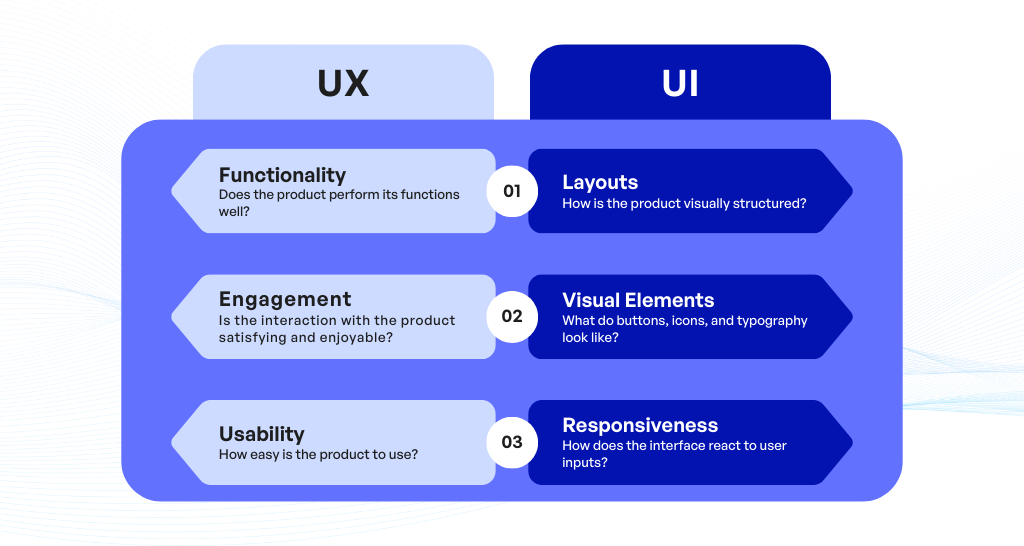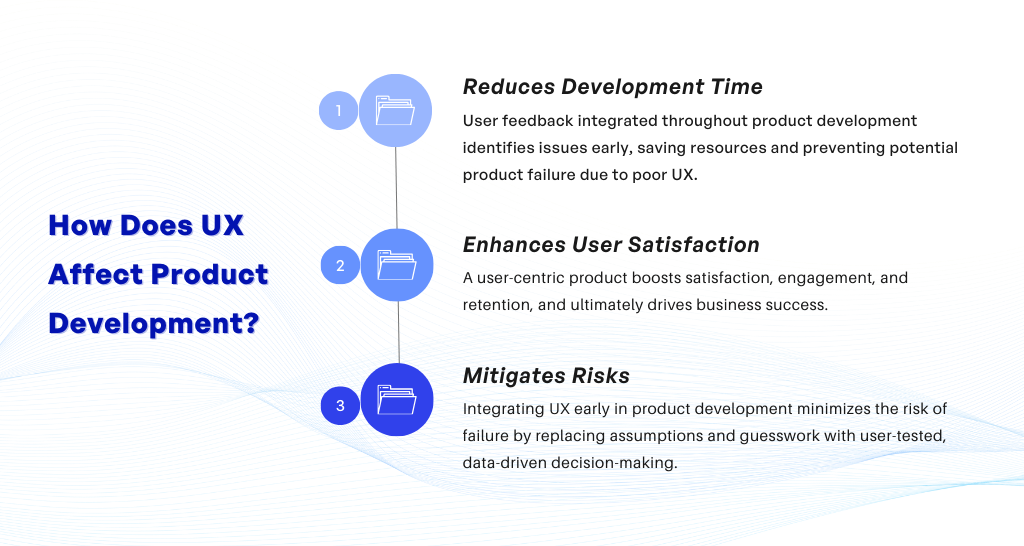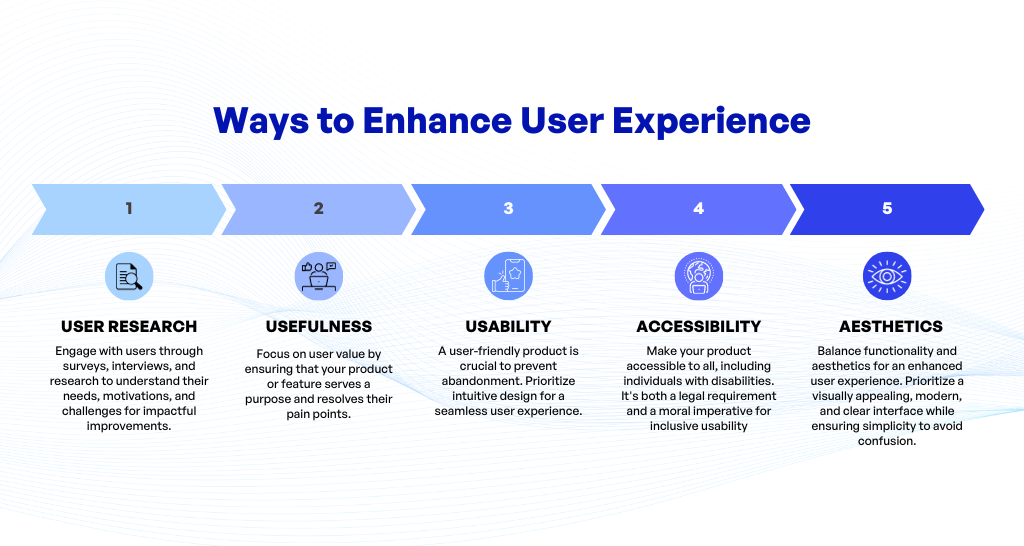
Have you ever stopped to think about how much user experience (UX) impacts your decisions? Whether it’s choosing a website to shop from, an app to download, or even a product to purchase, user experience plays a major role.
A well-designed user interface could raise your website’s conversion rate by up to 200%, and a better UX design could yield conversion rates up to 400%.
Forrester Research
Let’s dive into the basics of user experience in product development and find out why it matters and how you can enhance it. You’ll be surprised at the difference it can make to your product and your profits.
1. Introduction to User Experience
Have you ever wondered why you find some websites more intuitive than others? Or why do some mobile apps seem to anticipate your needs perfectly, while others get you endlessly clicking in frustration? Welcome to the world of User Experience, often abbreviated as UX.
At its core, user experience is all about how a person feels when interacting with a system, be it a website, a web application, or desktop software, and in general terms, any device or service. Aspects such as usability, accessibility, system performance, design/look and feel, utility, and ergonomic properties all commonly fall under the umbrella of user experience.
Although it might seem like a trendy buzzword, the concept of user experience is deeply rooted in human-computer interaction theories that date back to the 1980s. As technology continues to evolve, so too does our need for making digital systems more user-friendly. Isn’t it fascinating?
Now, you might be wondering, why is UX so essential, especially in product development. How can you enhance the user experience? What is its impact on the bottom line? Continue reading to unwrap the answers to all these questions and dive into the intriguing world of user experience. Shall we?
2. User Experience(UX) vs User Interface(UI)

Have you ever wondered about the difference between User Experience (UX) and User Interface (UI)? While they seem to be used interchangeably in conversations they hold distinct roles in product development. Let’s uncover what each term signifies.
User Experience (UX), as the name suggests, encompasses all the interactions and experiences a user has with a product. UX concentrates on the product’s usability, functionality, and how users perceive, interact, and feel about the product. Think of UX as the whole journey: from the moment a user discovers your product, to their interactions, feelings, and thoughts that transpire as they navigate through it.
UX covers:
- Usability: How easy is the product to use?
- Engagement: Is the interaction with the product satisfying and enjoyable?
- Functionality: Does the product perform its functions well?
On the other hand, User Interface (UI) is the specific asset users interact with. Essentially, UI is the point of interaction between the user and a digital product or service. This covers all the screens, buttons, icons, and visual elements that facilitate user interaction.
UI includes:
- Layouts: How is the product visually structured?
- Visual Elements: What do buttons, icons, and typography look like?
- Responsiveness: How does the interface react to user inputs?
In essence, while UX is about how the product feels, UI is about how the product looks. Both are essential to the product and work closely together. But remember, a product with an excellent UI can fail if it provides a poor UX, and vice versa. Therefore, a harmonious balance between UX and UI is crucial for a product’s success. Makes sense, isn’t it?
3. Why User Experience Matters in Product Development
So why does user experience matter in product development? Have you ever wondered why some products fly off the shelves while others stagnate? Often, it comes down to how users feel about the product – and that’s where user experience steps in.
User experience (UX) encapsulates all the interactions a person has with a product. It’s also about how they feel throughout the entire process, from the moment they first hear about it, to the point they try it out, and even when they stop using it. Translated to the world of product development, UX is about empathy and understanding your user’s needs, wants, and expectations.
Here are a few reasons why user experience is so critical to product development:
- Your product needs to be intuitive. A product that’s difficult to use will put people off, no matter how beautiful or innovative it may be.
- Good UX design can make your product stand out from the competition. In today’s saturated markets, a well-designed user experience can be the defining factor that sets your product apart.
- An excellent user experience helps retain users and foster loyalty. If users enjoy using your product, they’re more likely to continue using it and recommend it to others.
It’s important to remember, though, that understanding your users’ needs and translating them into a functional, enjoyable product isn’t always clear-cut. You’ll need to listen carefully, research thoroughly, and iterate constantly – but more on that in a bit. For now, just remember: the best products are those that put users first.
When developers understand how users will interact with their product, they can create a more user-friendly solution. It helps to identify potential issues and roadblocks early on, which can save time and resources in the long run. Moreover, optimizing your product based on the user’s perspective can increase sales and profits, but we’ll get to that later. The takeaway here? Investing in user experience isn’t just about aesthetics or usability; it’s about creating a product that truly meets your users’ needs.
How Does UX Affect Product Development?

The best products out there didn’t just happen by accident. They are the result of careful planning, perfect execution, and meticulous attention to user experience (UX). UX design iteratively improves the overall quality of the product, ensuring the final outcome is not only functional but also user-friendly and appealing.
But how, specifically, does UX injection into product development enhance its quality?
- Reduces Development Time: When user feedback is integrated at every stage of product development, it helps identify issues earlier, saving precious resources and time. This could mean preventing a product release that may fail due to poor UX.
- Enhances User Satisfaction: A product developed with user experience in mind is more likely to satisfy the users’ needs, leading to higher user engagement, retention, and ultimately, business success.
- Mitigates Risks: Incorporating UX in the product development process from the get-go reduces the risk of product failure drastically. It eliminates assumptions and guesswork, replacing them with user-tested, data-based decision-making.
But that’s not all; also worth mentioning is the role of UX in making the product’s user interface (UI) intuitive. Did you know that an intuitive UI reduces the learning curve for new users? Imagine your product being so easy to use that it feels like second nature to your customers! That’s the magic of a well-implemented UX design.
Finally, let’s not forget how UX can lead to an overall more meaningful interaction between your customers and your product. By understanding the user’s journey and their pain points, you can create a product that truly improves their lives, setting up a deeper connection with your brand.
Intriguing, isn’t it? Knowing that UX isn’t just about making products look pretty, but it’s about making products more effective and efficient, it’s clear to see how it monumentally influences product development.
4. Ways to Enhance User Experience

Are you ready to take your product to the next level with user experience? Yes, you certainly can! Knowing how to enhance user experience is a valuable skill that will significantly benefit your product development journey.
Following are some techniques that can help you improve user experience:
- User Research: Nothing beats hearing straight from the users themselves. Conduct user surveys, interviews, and research to understand their needs, motivations, and challenges. Use this information to make the necessary improvements.
- Usefulness: Ask yourself, “Is the product or feature useful to the user?” If it doesn’t serve a purpose or resolve a pain point, it may not enhance the user experience. Focus on creating value for your users.
- Usability: This pertains to the ease of use of the product. If users struggle to use the product or find the information they need, they’re more likely to abandon it. Make sure your product is intuitive and straightforward.
- Accessibility: Your product should be accessible to everyone, including those with disabilities. Accessibility is not only a legal requirement but also a moral one, ensuring that everyone, regardless of ability, can use your product efficiently.
- Aesthetics: While functionality is king, “looks” still matter. A visually appealing, modern, and clear interface can significantly enhance the user experience. But remember, simplicity is key; you don’t want the design to be distracting or confusing.
Keep those tips in mind, and you’re on your way to creating a product that not only meets your users’ needs but also provides an outstanding and enjoyable user experience.
5. The Impact of User Experience on Profits
You’re likely asking, “But how exactly does user experience play into my bottom line?” Well, it’s simple. The better a customer’s experience with your product, the more likely they are to use it, stick with it, and recommend it to others. This increase in user satisfaction and advocacy directly impacts your profits. Let’s break this down a bit further.
First and foremost, a positive user experience encourages repeat business. If you’re able to provide a product that meets a customer’s needs in an intuitive and pleasant way, they’re more likely to come back to you in the future. It saves them the time and effort of looking for an alternative to fulfill the same need. Can you see how this directly contributes to increased revenue?
Secondly, happy customers become brand advocates. Word of mouth is an incredibly powerful tool in business, and customers who have had a positive experience with your product are far more likely to recommend it to their friends and family. This organic promotion is priceless and can significantly bolster your profits.
Finally, a well-crafted user experience can help to reduce costs. Think about it – if your product is easy to use and meets a user’s needs well, then you can save significant amounts on resources spent handling customer complaints, processing returns, and fixing issues. Isn’t it incredible how good UX design can kill two birds with one stone?
In conclusion, the impact of user experience on profits is profound. Investing time and resources into optimizing the user experience of your product can bring about increased customer loyalty, more referrals, and lower operational costs – all factors that directly contribute to a healthier bottom line. So, isn’t it time you started taking UX seriously?
6. Final thoughts
Recapping, we’ve uncovered the vital principles of user experience in product development, right? We’ve discussed why it matters, how it affects the development process, and methods to enhance it. But let’s not forget the most important takeaway here – the profound impact it has on your profits.
You might think of user experience as something abstract, subjective, or even optional. But, as we’ve seen, it’s anything but. In reality, it’s a concrete, quantifiable aspect of your product that drastically affects its success in the market. And more directly, your profitability.
Remember, when you invest in user experience, you’re not only crafting a superior product, but you’re also building a connection with your users. This connection translates into greater customer satisfaction, loyalty, and ultimately, higher profit margins.
Investing time and resources in user experience might seem daunting at first. However, please keep in mind that the upfront effort will pay dividends in the long run.
So, what’s the primary message you should take from all this? UX matters – more than you might initially think. Make the leap, focus on the user, and the reward will follow.
Remember, successful user experiences aren’t crafted overnight. They require effort, adaptability, and a whole lot of user feedback. But when done right, the result is a product that not only meets user needs but also transcends them, setting new standards in the marketplace.
With all that said, we’ve come to the end of our exploration of user experience basics in product development. It’s now time to apply these insights to your own work and see the results for yourself.
If you have any questions regarding software development, feel free to contact KVY TECH.


